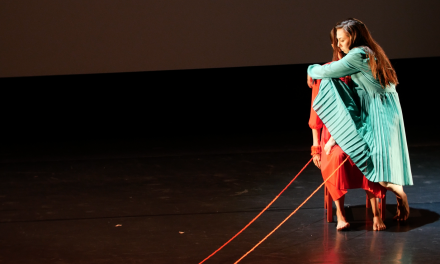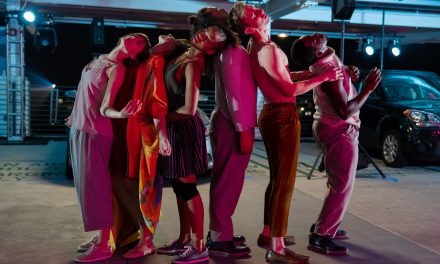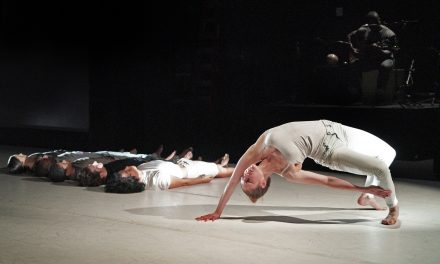September 26 – 28, 2019 The Wallis Annenberg Center for the Performing Arts hosted the acclaimed BODYTRAFFIC, as 2019-2020 Company-In-Residence. Also premiering was Michaela Taylor’s SNAP with works by Fernando Hernando Magadan, Matthew Neenan and L.A. Based Choreographic Duo Wewolf.
The evening began with (D)ELUSIVE MINDS – choreographed by Fernando Hernando Magadan, who first put his piece on its feet for Nederlands Dance Theatre (NDT). In the program he is credited as “multi-faceted,” also designing the Sets, Sound and Composition (with Harmen Straatman).
The set was an assemblage of crumbled ghostly books and papers upstage strewn in an arc across the stage with a legless armchair settled in its center. The set appeared to represent the chaotic world in the mind of the lead character…the rest of the stage was stark and empty save for a singular paned window hanging in midair down right.
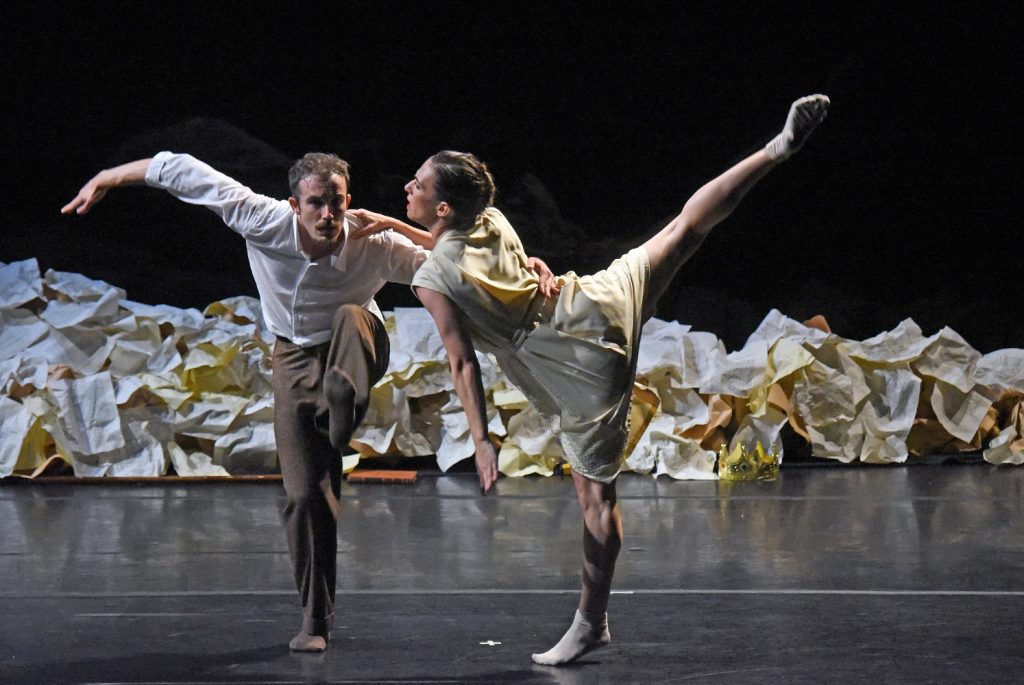
BODYTRAFFIC performs (d)elusive minds by Fernando Hernando Magadan at the Wallis Annenberg Center for the Performing Arts on September 26, 2019; (l-r) Guzmán Rosado, Tina Finkelman Berkett. Photo by Kevin Parry.
Magadan’s Music and Sound Editing acted as imperceptible babble as the audience entered the theatre. Then as the lights dimmed with the intermittent droning of the word scape, Schubert’s Trio for Piano, violin, and Violincelli Op. 100 became a gorgeous juxtaposition underlying the spoken words and phrases, “The King goes nuts,” “Nothing is what it seems”, etc. The movement and story were layered over it all. The collage of words, sound and set began to create guideposts assisted by the technically stunning Tina Finkelman Berkett and Guzman Rosado. Their superior partnering and structural body design were masterful. Rosado was particularly musical, sustaining and leading us right into the pocket of a surprise move or stop. Both were wonderful to watch dance-wise.
Unfortunately, the most important word guideposts dropped out and they became inaudible halfway through the piece, which left the audience on their own to tie the disjointed story together. It was questionable whether this was done on purpose, or it was because of technical difficulties.
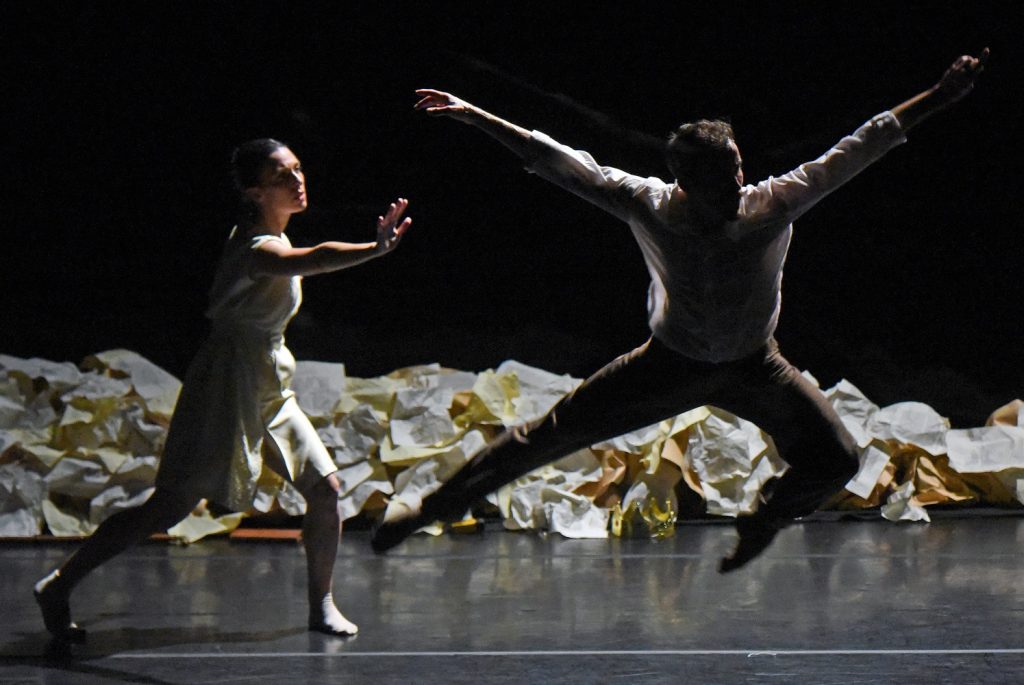
BODYTRAFFIC performs (d)elusive minds by Fernando Hernando Magadan at the Wallis Annenberg Center for the Performing Arts on September 26, 2019; (l-r) Tina Finkelman Berkett, Guzmán Rosado. Photo by Kevin Parry.
The noted mission of the piece was to probe the disparity between “reality and fiction, health and insanity, and the deceiving characteristics of appearances.” It was based on a true story of a mental patient, Santiago, with “Capgras Delusion”, a type of Schizophrenia, where the person believes the family member has been replaced by an imposter. He eventually kills his wife, and even in prison he continues to write her, believing she’s still alive.
No matter how clear this fascinating story appeared on paper, however, the story onstage seemed disjointed and opaque. Exploration of the actual depth of the personalities seemed to be quickly lost in caricatures. The layers called for more exploration to help the audience understand and feel…something. Connection and dramatic investment in the looming fate of the wife somehow was forfeited in the bravura of the dance. The story, at times was confusing without reading the notes, it seemed to be rushed and acted as a masked overlay of unexplored possibilities. It would have been wise to examine the great Sally Wilson’s “Lizzie Borden” a frightening interpretation of insanity. Observing and learning from this chilling tour de force would have made (D)ELUSIVE MINDS a classic work of art, and a more enduring dance drama.
Micaela Taylor ‘s SNAP highlighted the soul and music of the great James Brown, with original music and sound edition by Schocke. The “I Feel Good” opening separated the initiated from the novice. It evoked the games, the street, the conflicts with the rapport of the company for each other. Taylor, Berkett, Heckethorn, Joseph Davis, Ethan Colangelo and Jamal White thrilled the audience with their clear devotion to the material. With the use of their bodies and an internal drive, even in a moment of silence, the music still played on in their movement.
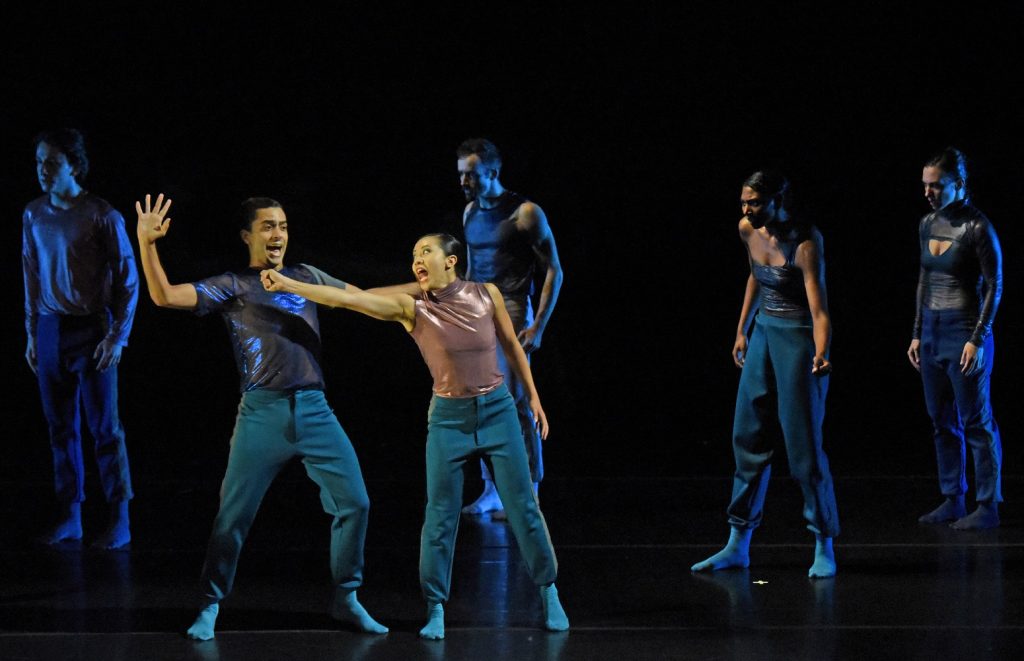
BODYTRAFFIC performs SNAP by Micaela Taylor at the Wallis Annenberg Center for the Performing Arts on September 26, 2019; (l-r) Ethan Colangelo, Joseph Davis, Tiare Keeno, Guzmán Rosado, Micaela Taylor, Tina Finkelman Berkett. Photo by Kevin Parry.
Without a doubt, Taylor’s choreography was masterful in leaving the audience wanting to get out of their seats and shake the house down, highlighting the joy of being at home in this material.
There was a skillful “interview scene,” “Sans” music with Taylor, Tiare Keeno, and Joseph Davis performed with intelligence and artistry; there was an energetic fight scene with Ethan Colangelo and Jamal White. And out of the darkness, It’s a Man’s World performed by Guzman Rasado, Jamal White and Heckethorn that so emotionally expressed the essence of Brown’s words, “This is a man’s world but it wouldn’t be nothing…without a woman or girl.”
The group truly supported the spirit of the piece. However, the essence and heart of Brown seriously exuded from the soul of Taylor. It was hard to take one’s eyes off her, as she expressed the urgency of the message. Taylor didn’t even have to move; she clearly was the conscience of the piece.
RESOLVE, choreographed by the duo Wewolf, with music by D.J. Tennis, was designed for two male dancers, Joseph Davis and Guzman Rosado, both technically facile and dazzling to watch with their mechanical moves, martial arts katas and body twisting inventions. Their complicated and intricate entwinements appeared to be set in three movements ending in brief silences.
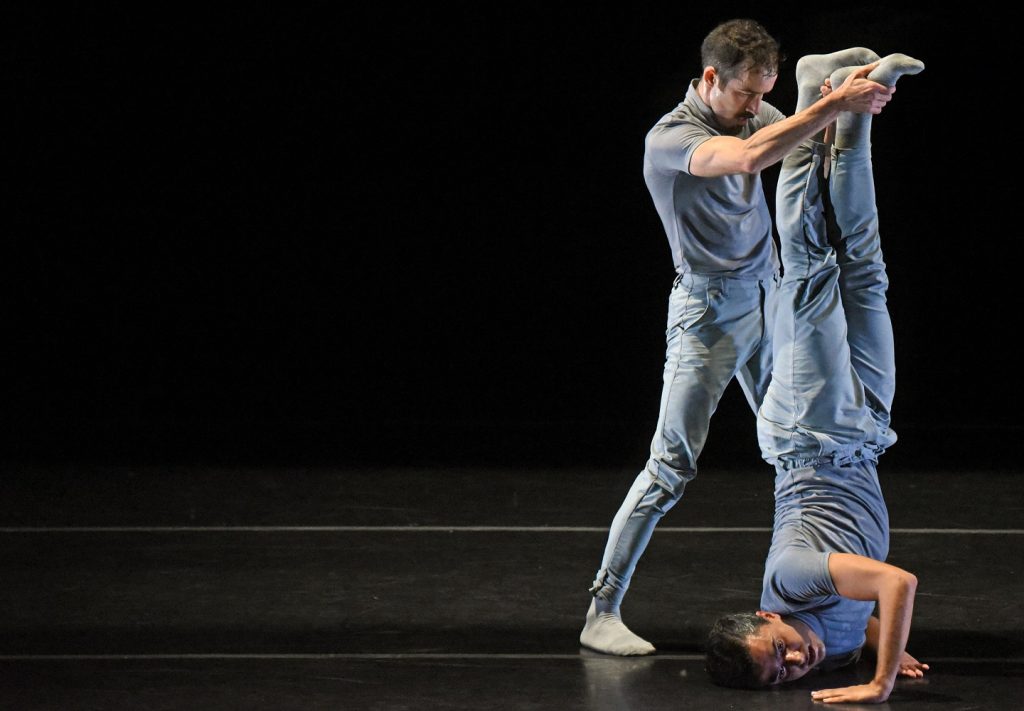
BODYTRAFFIC performs Resolve by WEWOLF at the Wallis Annenberg Center for the Performing Arts on September 26, 2019; (l-r) Guzmán Rosado, Joseph Davis. Photo by Kevin Parry.
The movements to be sure, were fascinating at first, with a hint of a relationship, not because it had been in the choreography but because of the innate communication between the two dancers. However, as the piece moved on to the second and third sections, no new or unique statements were added to the piece. “Resolve” turned into an exercise of intricacies that never said anything nor went anywhere. With all its complexity it played one note. The piece seemed to get lost in its own exploration, and its relevance went adrift as it continued to drone on.
The “Music” which started with an incessant beat and droning sound created plenty of tension. It also found no new direction, however, other than an amplified beat box with no place to go musically. Perhaps it tried to replicate the beat of the heart, or even attempted at the genius of Bolero without the acumen and musical growth. It is clear it will take more “resolve” to examine this piece more fully.
The last piece A MILLION VOICES was inspired by the steamy goddess of American Jazz and Pop, Peggy Lee, whose music-making spanned six decades from the 40’s and 50’s onward. The piece, choreographed by Matthew Neenan and performed by Tina Berkett, Joseph Davis, Haley Heckethorn Myles Lavallee, Guzman Rosado, Jamal White and Rachel Secrest made their way tirelessly through the styling of 40’s and 50’s with great aplomb.
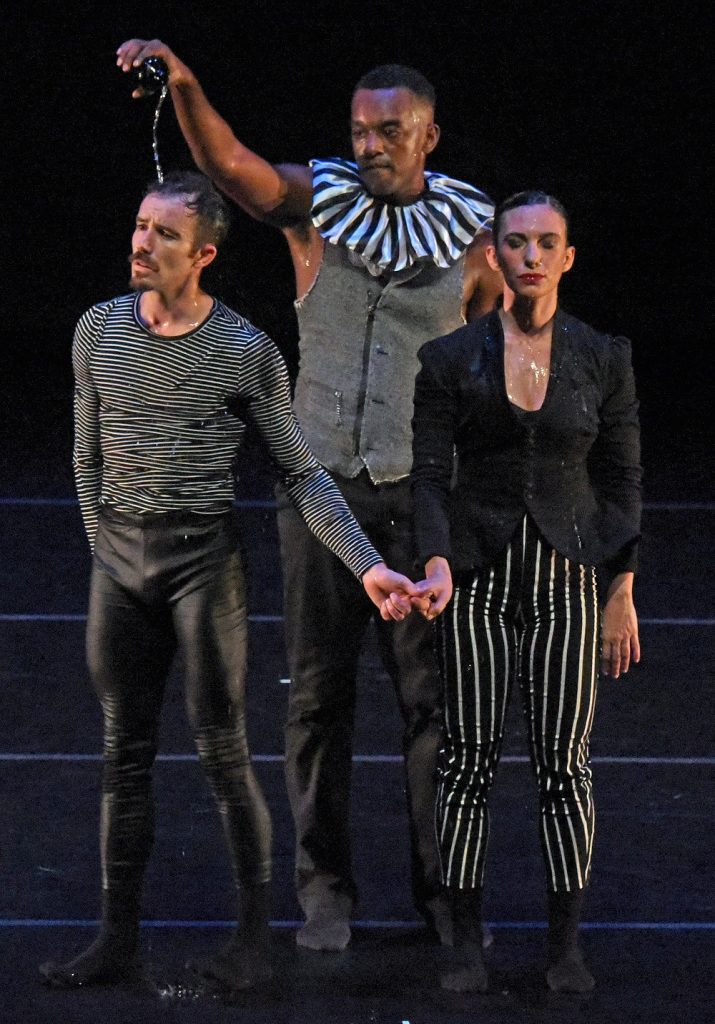
BODYTRAFFIC performs A Million Voices by Matthew Neenan at the Wallis Annenberg Center for the Performing Arts on September 26, 2019; (l-r) Guzmán Rosado, Jamal White, Tina Finkelman Berkett. Photo by Kevin Parry.
One of the true highlights of this piece was Rachel Secrest and Jamal White’s outstanding duet to Blues in the Night. Secrest’s amazing physicality and facile emotional artistry supported by Jamal White was a clear focal point of the work.
Berkett and Rosado, always technically excellent, and backed by a gaggle of characters, did a technically fun rendition of “Is that all there Is?” but was “fun” the message? It lacked the subtext, the emotionality of what was being expressed in the lyrics. Using not only the lines “If that’s all there is, so let’s keep dancing” but” Let’s break out the booze and have a ball” which was symbolized by a running joke of showering liquid over the two …masking the heartbreak of those lines.
There is no doubt, BODYTRAFFIC puts its all into each performance with its incredible facility, cleverness and outstanding performers. Now it’s time to consider working on “meaning and context” so the audience is fully pulled into the performance by their artistry.
Written by Joanne DiVito for LA Dance Chronicle, October 1, 2019
To visit the BODYTRAFFIC website, click here.
For more information about what is appearing at The Wallis Annenberg Center for the Performing Arts, click here.
Featured image:


